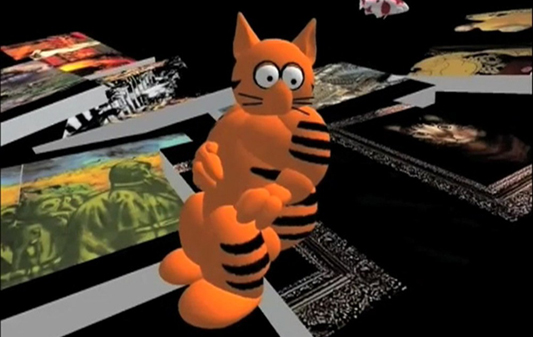Chris Marker (aka Christian François Bouche-Villeneuve) was best known as an experimental filmmaker, but he was also a graphic designer, photographer, activist, magazine editor and a pioneer on Second Life. He’s had an indelible influence on other contemporary artists and video essayists like Andrew Norman Wilson and Renzo Martens, preceding and inspiring these journalistic and political approaches to contemporary art practice.
For the UK’s first retrospective of Marker’s work at the Whitechapel Gallery, the series of disconnected multi-media elements is a sporadic but exploratory journey. In engaging with the diversity of his output –including his essay-films and experimental use of digital media –the exhibition attests to the diverse platforms across which he operated. It’s fragmentary approach to an exhibition, split into sections devoted to the themes of ‘Museums’, ‘Travel’, ‘Image’ & Text’, and ‘War & Revolution’, that leaves little room for contemplation.

Opening with a set of installations thematically organized around ‘the Museum’, the Chris Marker exhibition points to the animated work ‘Ouvroir: the movie’ (2010). Playing out in Second Life, the film replicates the online virtual world where users interact through avatars. Marker’s avatar ‘Monsieur Guillame’ is a CGI orange cat guiding visitors on a virtual tour of his works. That stands in stark contrast to ‘Statues Also Die’(1953) a 30-minute essay film focussed on the French colonial perspective of African art history, nearby and looking more than fifty years back. While you can draw your own conclusions on the link between these works, the transition between watching a digital feline frolic through a brightly animated virtual archipelago, to a call for recognition of African contributions to the arts in a time of intense racial conflict is harshly anachronistic.
But perhaps what unites the discordant selection of film art throughout the exhibition is the notion of travel. Many of Marker’s films appear as travelogues bridging documentary with fragments of memory and notions of science fiction. The ‘Travel’ section to follow deals with Marker’s ‘Petite Planète’ series (1954-1958), made up of illustrated guidebooks to various countries known for their lavish imagery and inventive layouts. With covers featuring an anonymous inhabitant from a given country, the books’ pages present photo montages that create a cumulative meaning through closely cropped stills, much like his films. Stylistic parallels could be drawn to Marker’s most well-known video work, ‘La Jetée’(1962), later remade by Terry Gilliam into Hollywood sci-fi classic 12 Monkeys. ‘La Jetée’ is composed entirely of stills, these static portraits of its characters meshing into a cinematic experience. Like his travel guides, the film is imbued with a sense of journalistic initiative, giving the impression that Marker is developing a personal relationship with both his viewers and his protagonists.
Ultimately, the importance of creating opportunities for reflection on these themes and ideas in favour of breadth is abandoned at Chris Marker, leading to a segmentation that disrupts the potential for a more fluid chronological or thematic trajectory. Yet, its this very fragmentation that parallels the extraordinary versatility of Marker’s practice, as well as the mercurial nature of his art. **
The Chris Marker retrospective is on at London’s Whitechapel Gallery, April 18 to June 22, 2014.













